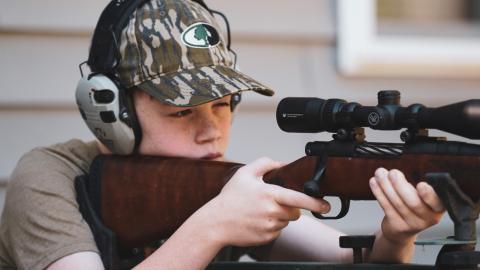Greg Kazmierski
When it comes to hunting mature bucks, understanding and utilizing scrapes can be a game-changer. Many hunters like to hunt scrapes during the pre-rut and rut, but with the right strategy, hunting scrapes can be productive throughout the season. This article will cover five key questions I often get that will help you develop a successful scrape hunting strategy this fall.
What is a Whitetail Scrape?

A whitetail scrape is an area where a deer or multiple deer (doe and buck) have cleared away debris with their hooves, exposing the dirt. Above the scrape, you'll typically find a licking branch where the deer deposits scent from its forehead glands. This combination of scent marking on the ground and branch is used to communicate with other deer, signaling a buck’s presence to does and other bucks in the area. A mature buck likes to use scrapes to monitor the activity of the deer herd as well as to establish dominance within their core areas.
Scrapes are often found near bedding areas, food sources, and along travel routes. Primary scrapes, or scrape lines, can be highly active during the pre-rut as bucks ramp up their scraping activity in the weeks leading up to the rut. Locating scrapes in these transition zones is key to your hunting success.
What Time of Day Do Bucks Check Scrapes?

Scrape visits by bucks can happen at any time, but a majority of scrape activity is throughout the middle of the night, outside of legal hunting hours. Mature bucks often visit scrapes under the cover of darkness to avoid hunting pressure and other risks. However, during the pre-rut and rut, daytime scrape visits become more common as bucks move more frequently in search of does.
For hunters targeting active scrapes, an evening hunt near thick bedding areas or in transition zones between bedding and feeding areas can increase the odds of catching a buck on his feet during daylight. Trail cameras can also help determine what time of day a particular scrape location is being visited, allowing you to adjust your strategy accordingly.
What Time of the Year Do Bucks Make Scrapes?
Scrapes can be made and tended to at any point of the year, but the peak scrape-making period happens in the weeks leading up to the rut, usually from mid-October to early November. This is when bucks are most active in marking territory, checking for does, and monitoring the movements of other bucks. Late October, in particular, is my favorite time for hunting scrapes as the rut nears and bucks become more aggressive.
While most scrapes are made during the pre-rut, don’t overlook scrape hunting during other times of the year. Some bucks will maintain scrape sites throughout the season, especially if they feel the area offers low hunting pressure and access to does. This is why not all scrapes are created equal—focus on locating a primary scrape near key travel routes, bedding areas, or security cover for the best shot opportunities.
Are Mock Scrapes Worth It?

Yes, creating mock scrapes can be a highly effective way to increase deer activity in your hunting area. Many hunters use mock scrapes to attract bucks, gather buck inventory via trail cameras, and increase the chances of a shot opportunity at a specific location that pairs with secure hunter access. A well-placed mock scrape, especially near transition areas or bedding areas, can encourage bucks to visit scrape locations you’ve established.
Mock scrapes work best when they mimic the natural signs of an active scrape. Start by choosing a good licking branch at your desired location. Scrape away the dirt below the branch to expose the ground, and consider using scents to simulate a buck or doe’s presence. Bucks are drawn to these mock scrapes because they trigger the same instinctual behaviors as natural scrapes.
How Do You Hunt Mock Scrapes?
Hunting mock scrapes requires a similar approach to hunting natural scrapes. Some of my best mock scrapes are in areas that offer bucks easy access to both food sources and secure bedding, such as field edges, staging areas, and transition zones. You want to place your mock scrape in a spot where it can be part of the natural travel routes bucks use during their daily movements.
When hunting a mock scrape, it's important to be mindful of how often you hunt it. Overhunting a scrape location or having poor access to your stand can spook deer, especially a mature buck. Also, be flexible—scraping activity may increase or decrease depending on factors like weather and hunting pressure. If you aren’t seeing the activity you expected at one scrape, be ready to make a move
Mock scrapes are particularly effective during the two weeks leading up to the rut. During this time, bucks will be actively visiting scrape lines and primary scrapes, looking for does. Set up within bow range of an active scrape or mock scrape, and you may find yourself with a big buck in front of you during those critical few weeks.
Conclusion
Hunting scrapes is a tried-and-true tactic for targeting mature bucks during the pre-rut and rut, but it requires a well-thought-out strategy. By understanding how and when bucks visit scrapes, locating the right scrape locations, and incorporating mock scrapes into your game plan, you can significantly improve your chances of success.
Use trail cameras to monitor scrape activity, focus on secure access routes to avoid spooking deer, and don’t be afraid to adjust your setup as conditions change. With the right approach, hunting scrapes can lead to more encounters with mature bucks and better shot opportunities.




























